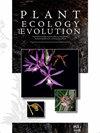阿富汗加迪兹近危种gerardiana的遗传多样性和精细尺度空间遗传结构
IF 1.1
4区 生物学
Q3 PLANT SCIENCES
引用次数: 0
摘要
背景和目的—Chilgoza松树(Pinus gerardiana)是喜马拉雅山西北部的一种近危树种。该树种是阿富汗经济上最重要的松树,因为它的坚果可食用;然而,其分布范围是不连贯的,局限于少数孤立的地区。世界自然保护联盟将Chilgoza列为近危物种,因为它的坚果被过度开采,而且数量呈下降趋势。这项研究是首次利用微卫星标记对阿富汗Chilgoza的遗传变异和结构进行深入分析。材料与方法-对44个松树种SSR标记进行交叉扩增试验。在阿富汗加迪兹的Chilgoza自然种群中对8个EST-SSRs进行了基因分型。为了评估遗传多样性、精细空间遗传结构、瓶颈事件特征和有效群体大小,对191棵树进行了基因分型。根据胸高处的直径,将个体分为幼树和老树。关键结果-整个人群的遗传变异是适度的。对于单个标记物,He范围为0.130 ~ 0.515(平均= 0.338),Ho范围为0.118 ~ 0.542(平均= 0.328)。幼树的预期杂合度略低于老树。幼树的SGS效应(Sp = 0.0100)强于老树(Sp = 0.0029)。杂合度过剩分析没有发现最近的种群规模减少,但M比揭示了Chilgoza种群存在一个古老而长期的瓶颈。结论-鉴定适合的EST-SSRs,为今后对Chilgoza自然种群的研究提供了重要的保护工具。尽管加迪兹的遗传变异适度,但自然再生的稀缺性可能会降低后代的遗传变异和适应性。我们的研究结果表明,遗传多样性略有下降,幼树的遗传多样性较强,需要采取保护措施促进自然再生。本文章由计算机程序翻译,如有差异,请以英文原文为准。
Genetic diversity and fine-scale spatial genetic structure of the near-threatened Pinus gerardiana in Gardiz, Afghanistan
Background and aims – Chilgoza pine (Pinus gerardiana) is a near-threatened tree species from the north-western Himalayas. This species is the economically most important pine in Afghanistan because of its edible nuts; however, its distribution range is disjunct and restricted to a few isolated regions. The IUCN lists Chilgoza as a near threatened species because of overexploitation of its nuts and a declining population trend. This research is the first in-depth analysis of the genetic variability and structure of Chilgoza in Afghanistan using microsatellite markers.
Material and methods –We tested cross-amplification of 44 SSR markers developed for pine species. Eight polymorphic EST-SSRs were genotyped in a natural Chilgoza population in Gardiz, Afghanistan. To evaluate the genetic diversity, fine-scale spatial genetic structure (SGS), signatures of bottleneck events, and the effective population size, 191 trees were sampled and genotyped. Based on the diameter at breast height, individuals were classified as young or old trees.
Key results – Genetic variation in the whole population was moderate. For individual markers, He ranged from 0.130 to 0.515 (mean = 0.338) and Ho from 0.118 to 0.542 (mean = 0.328). The expected heterozygosity in young trees was slightly lower than in old trees. The SGS was stronger for young trees (Sp = 0.0100) than for old trees (Sp = 0.0029). Heterozygosity excess analysis detected no recent population size reduction, but the M ratio revealed an ancient and prolonged bottleneck in the Chilgoza population.
Conclusion – Identification of suitable EST-SSRs for future studies of natural Chilgoza populations provides important tools for the conservation of the species. Despite the moderate genetic variation in Gardiz, scarcity of natural regeneration is likely to reduce the genetic variation and adaptability in future generations. Our results indicated a slight decrease in genetic diversity and stronger SGS in young trees calling for conservation measures fostering natural regeneration.
求助全文
通过发布文献求助,成功后即可免费获取论文全文。
去求助
来源期刊

Plant Ecology and Evolution
PLANT SCIENCES-
CiteScore
2.20
自引率
9.10%
发文量
27
审稿时长
>12 weeks
期刊介绍:
Plant Ecology and Evolution is an international peer-reviewed journal devoted to ecology, phylogenetics and systematics of all ‘plant’ groups in the traditional sense (including algae, cyanobacteria, fungi, myxomycetes), also covering related fields.
The journal is published by Meise Botanic Garden and the Royal Botanical Society of Belgium.
 求助内容:
求助内容: 应助结果提醒方式:
应助结果提醒方式:


